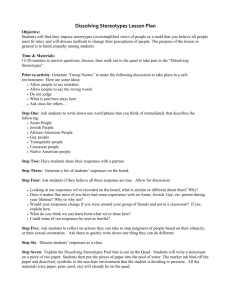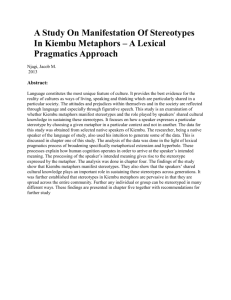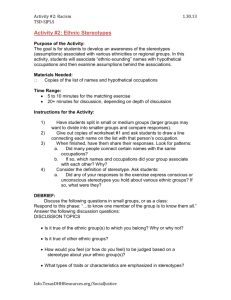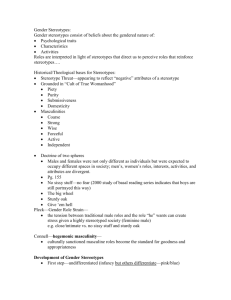Catherine Lido from Thames Valley University
advertisement
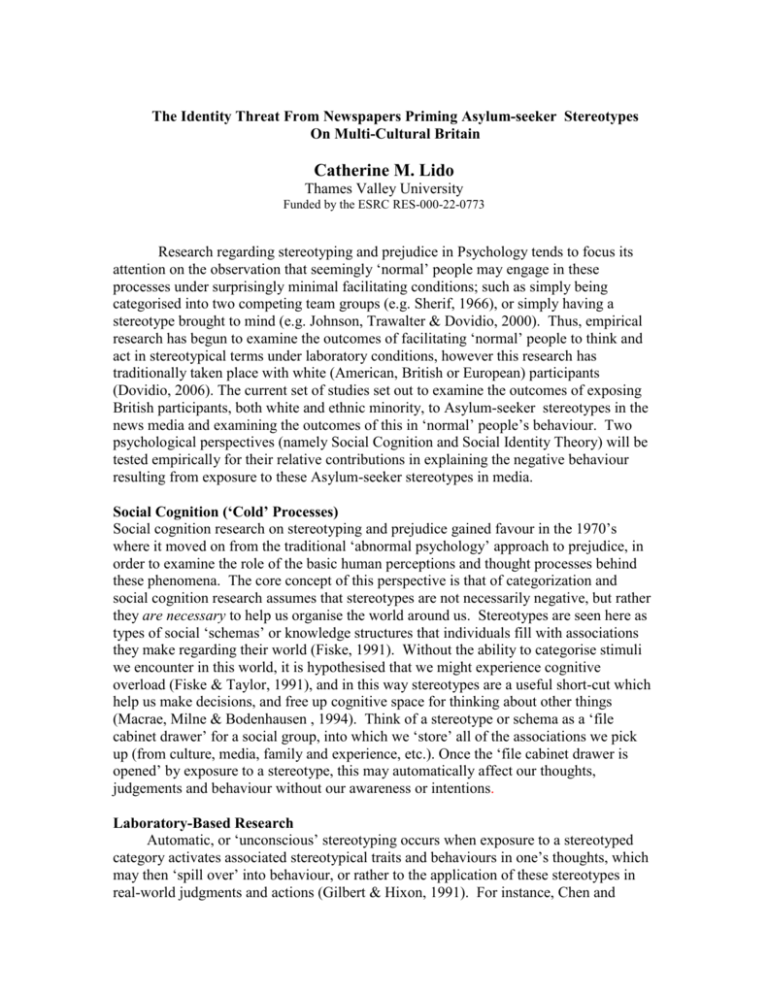
The Identity Threat From Newspapers Priming Asylum-seeker Stereotypes On Multi-Cultural Britain Catherine M. Lido Thames Valley University Funded by the ESRC RES-000-22-0773 Research regarding stereotyping and prejudice in Psychology tends to focus its attention on the observation that seemingly ‘normal’ people may engage in these processes under surprisingly minimal facilitating conditions; such as simply being categorised into two competing team groups (e.g. Sherif, 1966), or simply having a stereotype brought to mind (e.g. Johnson, Trawalter & Dovidio, 2000). Thus, empirical research has begun to examine the outcomes of facilitating ‘normal’ people to think and act in stereotypical terms under laboratory conditions, however this research has traditionally taken place with white (American, British or European) participants (Dovidio, 2006). The current set of studies set out to examine the outcomes of exposing British participants, both white and ethnic minority, to Asylum-seeker stereotypes in the news media and examining the outcomes of this in ‘normal’ people’s behaviour. Two psychological perspectives (namely Social Cognition and Social Identity Theory) will be tested empirically for their relative contributions in explaining the negative behaviour resulting from exposure to these Asylum-seeker stereotypes in media. Social Cognition (‘Cold’ Processes) Social cognition research on stereotyping and prejudice gained favour in the 1970’s where it moved on from the traditional ‘abnormal psychology’ approach to prejudice, in order to examine the role of the basic human perceptions and thought processes behind these phenomena. The core concept of this perspective is that of categorization and social cognition research assumes that stereotypes are not necessarily negative, but rather they are necessary to help us organise the world around us. Stereotypes are seen here as types of social ‘schemas’ or knowledge structures that individuals fill with associations they make regarding their world (Fiske, 1991). Without the ability to categorise stimuli we encounter in this world, it is hypothesised that we might experience cognitive overload (Fiske & Taylor, 1991), and in this way stereotypes are a useful short-cut which help us make decisions, and free up cognitive space for thinking about other things (Macrae, Milne & Bodenhausen , 1994). Think of a stereotype or schema as a ‘file cabinet drawer’ for a social group, into which we ‘store’ all of the associations we pick up (from culture, media, family and experience, etc.). Once the ‘file cabinet drawer is opened’ by exposure to a stereotype, this may automatically affect our thoughts, judgements and behaviour without our awareness or intentions. Laboratory-Based Research Automatic, or ‘unconscious’ stereotyping occurs when exposure to a stereotyped category activates associated stereotypical traits and behaviours in one’s thoughts, which may then ‘spill over’ into behaviour, or rather to the application of these stereotypes in real-world judgments and actions (Gilbert & Hixon, 1991). For instance, Chen and Bargh (1997) found that presenting individuals with a prime to rudeness led participants to interrupt the experimenter more quickly; Dijksterhuis and van Knippenberg (1998) showed that individuals who were made to think and write about the stereotype of a University professor, actually performed significantly better on a trivia quiz than those who had not. They also found that thinking about soccer hooligans can decrease performance on a trivia test. Additional studies demonstrate induction of overt racism and sexism following media primes, rather than behavioural imitation/ mimicry. For instance, Rudman and Borgida (1995) found that men exposed to sexist beer commercials chose more sexist questions for a female interviewee. With regard to ethnicity, Johnson et al. (2000) found that exposure to violent rap music led both Black and White individuals to make violent evaluations of a minority member (‘Leroy’), which also affected judgments of his intelligence and job qualifications. Johnson et al. (2000), showed that rap music primes also led to stereotype imitation in more aggressive participant behaviour. It would seem then, that there may be links between these automatic behaviours. Again these unusual findings have traditionally explained as the ‘file cabinet drawer’ being opened and stereotypical associations being to spread, hence it is referred to as ‘spreading activation’ (Fiske, 1991). In other words the category of ‘Elderly’ activates the association of ‘slow’. Wheeler and Petty (2001), however drew a distinction between this purely brain-based (cold) explanation and more ‘group-based’ emotional process, such as the anxiety experienced when encountering a threatening stereotype. Group Processes (‘Hot Processes’) Social Identity Theory (Tajfel & Turner, 1979) examines how individuals feel the need to belong to groups, and to categorize themselves and others as belonging to various groups. The key notion in SIT is that our identity (or self-schema) is largely defined by the social groups we belong to, in this way our social identity is our “group-based aspect of self-definition” (Reynolds & Turner, 2002, p.163). Furthermore, we, as humans strive to feel good about ourselves, and the Self-Esteem Hypothesis states that if we maintain a positive view of group, we will then have a positive ‘social identity’ and hopefully this will help us form a positive ‘personal identity’. In this way, we seek to differentiate our ‘in-group’ as positively distinct from an ‘out-group’ (Tajfel & Turner, 1986). The efforts to maintain this positive distinctiveness might even result in openly derogatory attitudes and behaviour toward an out-group, namely prejudice (Brown, 1995). As can be seen, SIT focuses more on ‘hot’ emotional thoughts and prejudiced behaviours rather than the ‘cold’ cognitive processes behind. SIT was expanded by SelfCategorisation Theory (SCT; Turner et al., 1987), adding that the answer to ‘who am I?’ is largely determined by the social context. In some contexts we might define ourselves and behave consistently with a social group, and we may even experience ‘depersonalisation’. SCT also predicts ‘identity switching’, whereby one group identity can be made ‘salient’ to an individual based on the context at hand (Oakes, Haslam & Turner, 1994). Therefore, sometimes a British ethnic minority participant might act more in line with British group norms or sometimes with ethnic minority group norms, and sometimes just as a person! Testing Automatic Stereotype with a Diverse Sample A set of ESRC funded studies by Lido, Brown, Calitri and Samson (2005) set out to test how Asylum-seeker stereotypes might unconsciously influence the behaviour of Britons. The participants were Psychology students (majority female) from 2 University sites in the Southeast of England. Firstly, these participants were first given a short news article to read, which either discussed Asylum-seekers in a positive light (honest), a negative light (dishonest/ criminal) or a neutral article (trainspotting). They were then asked to do the following (ostensibly) unrelated tasks. Secondly, in order to measure the use of these stereotypes toward Asylum-seekers, a job-matching task’ was administered asking participants to match white and ‘Asylum-seeker’ faces to various jobs which varied in terms of how honest they were (e.g. airport baggage handler vs. car mechanic). A follow-up study was conducted where the automatic use of stereotypes involved straightforward judgments about ‘applications’ for individuals seeking asylum in the UK. Thirdly, in order to assess honest vs. dishonest behaviour imitation, this study employed a female ‘confederate’ to act as a second researcher and attempt to pay the participant a second time. A follow-up study was conducted on the Internet, with the measure of honesty assessed via a questionnaire from the Eysenck and Eysenck’s (1991) EPQ-R lie scale. Finally, a self-reported (overt) measure of identification with being British and prejudice toward Asylum-seekers were measured (Calitri, 2006), but yielded no differences. Hypotheses It was hypothesised (using a ‘cold’ social cognition perspective) that exposure to positive and negative newspaper articles would lead all participants to activate stereotypical traits, leading to imitated dishonest behaviour (H1) and judgements about Asylum-seekers (H2). The role of individual differences; identification with being British, levels of existing prejudice and ethnicity were examined for their role (according to SIT). Results H1 Behavioural Imitation Behavioural imitation was evidenced for the white British participants only. However, unexpectedly, those who read either negative or positive news regarding Asylum-seekers exhibited more dishonesty than the unrelated article condition (p<.05). Thus, white British participants primed with Asylum-seeker stereotypes, whether honest or dishonest, were more likely to engage in dishonest behaviour by accepting an additional payment than individuals who read the unrelated article. A follow-up study was conducted with an additional white British sample online and replicated the finding that individuals exposed to either positive or negative news scored significantly higher in dishonesty on a lie-scale than those who read the unrelated article (p<.05). H2 Automatic application of stereotypes task The ethnic minority participants exposed to the negative article paired less Asylumseeker pictures with honest jobs than those who read the unrelated article (p=.06, but not significantly less than the positive article condition). This finding was weak therefore, a follow-up study was conducted. When exposed to either the negative or the positive Asylum-seeker news, the ethnic minority Britons gave lower ratings on the Asylum- seeker applications. As in all the findings above there were NO ethnic differences in the neutral (control) conditions. Discussion: Automatically Negative Behaviour Following Asylum-seeker News Reading The Lido et al (2005) research revealed that exposure to both positive and negative Asylum-seeker stereotypes in news articles led to negative stereotype-consistent behaviours. This occurred regardless of the individuals’ self-reported prejudice level. One might ask; Why no positive behaviours from the positive article? The present research program began with an analysis of newspaper content, revealing only 2 articles portraying Asylum-seekers as unambiguously honest (see also Oxfam, 2001 report). It’s clear that there is a stronger media/ cultural association of Asylum-seekers with negative traits and behaviours than positive. Thus, the positive ‘counter-stereotypical’ article attempted to trigger positive stereotypical associations regarding honesty that do not exist in British participants’ schemas or ‘file cabinet drawers’ for Asylum-seekers, and instead, when the drawer is opened, the dishonest ‘default’ behavioural associations abound. Ethnic Differences in Behaviour Expression The second interesting finding was that the ‘type’ of negative behaviour that was elicited (namely automatic application of stereotypes toward Asylum-seekers or mimicry in own behaviour) differed by ethnicity. It was thought that all participants would illustrate a simple ‘spreading activation’ of the Asylum-seeker stereotype, which would then ‘leak over’ into both behaviours. Instead, the white British sample replicated the ‘common’ psychological finding of automatic imitation of a stereotype. The stereotype exposure activated their stereotype content producing behaviour in-line with the stereotype, consistent with a simple ‘cold’ cognitive explanation. In direct contrast, the British ethnic minority participants engaged in automatic application of the stereotype toward Asylum-seekers. It is extremely important to note that these participants are NOT higher in overt prejudice toward Asylum-seekers, nor do they identify any less with being British. These effects ONLY occurred when ethnic minorities were primed with news articles. This is therefore most easily explained by these participants experiencing a ‘hot’ identity threat. That is, the negative stereotypes of ‘another’ minority group in Britain (in fact, a ‘lower status’ group) may have threatened the ethnic minority identity of the participants. This threatened their positive distinctiveness from other social groups (namely, Asylum-seekers). The Self-esteem Hypothesis would support that the automatic derogation of the ‘out-group’ Asylumseekers on the job and application-rating tasks should counter the effects of the threat. This happened unconsciously, without effort or awareness. Conclusion Firstly this research implicates the media in its role in constructing the social content of stereotypes, and namely constructing the negative content of Asylum-seeker stereotypes. Secondly, this research illustrates the immediate and unconscious influence negative stereotypes in the media may have on all of our behaviour. However, if this research had only been conducted with white British students, it would have supported a very simple ‘cold’ cognitive theory regarding how unconscious or automatic stereotypes lead us to mimic behaviour. However, the inclusion of minority students with multifaceted identities, allowed us to identify a more complex ‘hot’ identity threat process and therefore, this program goes someway in examining the role that multiple group identities can play in producing ‘hot’ affective responses in seemingly straightforward laboratorybased experiments. This research highlights the importance of not generalising findings with white participants to minority participants in Psychological research.
